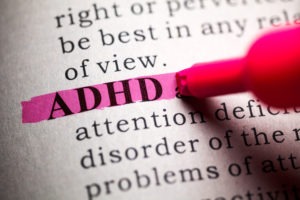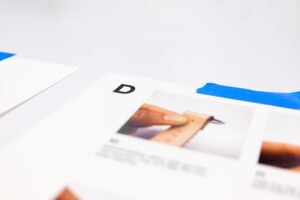My ADHD & Me: Making the Case for Disability Representation in the Public Relations Field
Published on Feb. 6, 2023, at 4:48 p.m.
by Trinity Hunter.
According to the Centers for Disease Control and Prevention, attention deficit hyperactivity disorder is a neurological developmental disorder. Commonly diagnosed in children, identifiable traits of ADHD include an inability to maintain focus, impulsivity and difficulty in social settings. Though the disorder is relatively well-known and has become more researched by the day, the road to the current perception of ADHD has been a winding one.

A quick history lesson
The origin of ADHD recognition is up for debate. Some researchers point to the first clinical description as coming from George F. Still in 1902; there is discrepancy on the overall timeline of when the disorder was first recognized. Known as the father of British pediatric medicine, Still described 43 children in his study as having difficulty sustaining attention and being able to regulate themselves. He even went so far as to say that they could be aggressive and passionate, with a failure to learn from their own mistakes. Yet their intelligence was never called into question.
As mentioned, Still is credited for the first clinical account of what is now known as ADHD. Numerous researchers credit Hippocrates, an ancient Greek physician who has is lauded as the father of medicine, as being the first to observe ADHD. He wrote about how some of his patients had difficulty focusing, and he described it as having an “overbalance of fire over water” in their heads.

The next person to notice a common theme among their patients was Sir Alexander Crichton, a Scottish physician. Crichton authored a book titled “An Inquiry into the Nature and Origin of Mental Derangement: Comprehending a Concise System of the Physiology and Pathology of the Human Mind and a History of the Passions and their Effects,” in which he noticed a certain group of children having heightened difficulties in maintaining focus. His writings about the “disease of attention,” pointed to how the individuals he studied could be “agitated” by any change in stimuli — such as a person walking in or out of a room, too much light or too little, and more. His patients explained that they had the “fidgets,” and he implored teachers to adjust their education to accommodate these students.
COVID-19 & a new diagnosis
To put it simply, the 2020-2021 academic year was excruciating. All online classes, social isolation and more contributed to a depletion in my mental well-being. Above all else, I was having a difficult time with my schoolwork. Maintaining my focus on assignments became nearly impossible, and I found myself losing motivation to do anything until the 11th hour, both figuratively and literally.
It was not until a conversation that I had with my parents that I recognized I needed help. While speaking with my father, I stated over the phone that it “felt like my brain was splitting in half.” The calamity of deadlines, responsibilities, emails, texts, phone calls and more were all contributing to the incessant buzz within my brain. It was debilitating and embarrassing; though everyone struggled from different aspects of the pandemic, none of my friends seemed to be toiling in the way that I was.
At the encouragement of my family, I traveled from Tuscaloosa to Hoover, Alabama. It was at Focus MD that I received news of my official diagnosis: ADHD.
In that moment, my life flashed before my eyes. Memories of losing focus while doing my calculus homework, struggling to sit still during a particularly boring movie, and a failure to pick things up at the same speed as my peers flooded back to me. The past two decades had been one of an invisible battle, to the point where I had accommodated to my external environment in ways I had forgotten.

Naturally, the next step was to heavily research ADHD. After all, I finally had a name for my incessant obstacle, and I would no longer let it get in my way.
Wading through murky waters
What is ironic about researching ADHD is that it requires a certain amount of attention that was difficult for me to acquire. Nonetheless, I found one consistent answer: The definition and symptoms of ADHD are just as confusing as one might expect.
According to Children and Adults with Attention Deficit/Hyperactivity Disorder (CHADD), ADHD presents in three ways: inattentive, hyperactive or combination. The notion of a person with ADHD being inattentive is confusing to many; the normal stereotype of the disorder is one of a child bouncing off the walls. Not only this, but there is a severe lack of inclusivity in its diagnostic pool. White children are more likely to be diagnosed with ADHD than their racial minority counterparts, as highlighted in a report in the National Library of Medicine.
The hyperactive characterization of ADHD presents as someone who has difficult sitting still, has impulsive tendencies and potentially makes an accidental habit out of interrupting people. Knowing the history of ADHD, it makes sense why this form of the disorder is the most well-researched, and thus, well-represented. However, for me, my journey revealed a mainly inattentive nature.
Predominantly inattentive ADHD will present in more subtle ways — difficulty with executive functioning, easily distracted or forgetful, and an increased likelihood of “daydreaming.” This presentation is historically more common in women, showing that there is a definitive difference between male-identifying and female-identifying people when it comes to ADHD. With the alternate presentation of symptoms, as well as a healthy dose of sexism, women are more likely to be underdiagnosed for ADHD.
Reaching adulthood without a diagnosis can be detrimental to the social and psychological health of a person with the disorder. A consistent trait in ADHD, regardless of individual presentation, is that there is a critical lack of dopamine in the brain. Dopamine, or the “reward” chemical messenger of the brain, is what sparks when a person completes some sort of action that makes them feel happy. Eating sweet treats or watching a favorite movie can initiate a dopamine transition in the brain. However, so can drugs and alcohol.

With the natural lack of dopamine in the brain, it is instinctive for a person to be on an incessant search for the chemical. Therefore, it is more likely that people with undiagnosed ADHD will experience some sort of “comorbid” disorder, such as anxiety, depression or bipolar disorder (BPD). Additionally, researchers have found a strong link between ADHD and addiction; teenagers and adults who go untreated may engage in risky sexual behavior, drugs, alcohol, gambling and other dopamine-stimulating activities.
OK, enough with the science lesson. What does this mean for PR?
Thoroughly researching ADHD was bittersweet. For years, I had been frustrated with myself.
Why could I not pay attention? Why was it so harder for me to process what people were saying? Why, above all else, did I seem to be struggling to do things that others found to be easy?
My diagnosis allowed me to understand that there was nothing wrong with me; I had a disability, and there was nothing I could do about it. Yet, the second part of that realization also felt like a trap. The world we live in is not designed for neurodivergent people. My friends will never understand why sometimes I need to sit in a quiet room, and other times I might need to listen to music with the television on in the background (sound on or off, depending on the day).
Through the frustration, I unintentionally found a new love: public relations.
A public relations specialist must be skilled in garnering the attention of priority publics. In order to do be a competitive practitioner, an individual must rise above in writing, editing, design and more. Though some qualities in a PR professional stand in opposition to ADHD (long-term planning, for instance), I have found that my disability has been more beneficial than detrimental.
For one, ADHD has made me a better writer and editor. Because it takes me longer to understand topics than my peers, my knowledge of them goes deeper than the average person. This investigative nature translates into my writing, where I make a regular habit of fully explaining anything, sometimes ad nauseam. This difficulty in comprehending subject matter is not uncommon for neurodivergent people; in fact, studies show that autistic individuals may not pick up the social cues, or communicate in the same way, as their non-autistic peers.
Though my failure to grasp issues at the same speed as other people has been a source of internal irritation, I have been able to continually apply my initial confusion to my writing. Encouraging fellow writers to flesh out topics or rework sentences for flow has become commonplace in my editorial journey, and I am confident that a person can never explain too much.

Lastly, ADHD has done wonders for my work in visual design. Every day is a constant battle to develop a new strategy in maintaining my attention span, and arresting the focus of viewers is the desire of every designer when creating a new piece. Sometimes, I have a natural inclination toward sans serif font or serif. Other times, I have an unexplainable desire to place pictures in corners or add alternate colors throughout. Although beauty is in the eye of the beholder, I credit ADHD with allowing me to perform consistently in my design pursuits.
In order to grow, we must engage those who have been historically marginalized.
The road to disability rights within the United States has been marred by exclusionary practices and stagnant bias. According to the Anti-Defamation League (ADL), 40.7 million within the United States have a disability, meaning 12.2% of the population is consistently trying to be recognized for more than one portion of their identity.
The golden rule states that all people should treat those around them in the same way they would want to be treated. This sentiment also applies to public relations and other industries. If the main purpose behind our industry is to cultivate authentic relationships with our target audience, then inclusivity cannot be an afterthought.
With the world designed for neurotypicals, there must be a conscious decision to create pieces with accessibility in mind. Just because everyone does not need accommodations does not mean they do not benefit from them. Inventions such as the typewriter and telephone were created with disability rights in mind.
So, even though I may wait until the last minute to do assignments, forget to make phone calls or “zone out” during class discussion, I have found more pride in my disability than any other emotion. My ADHD and me, forever and always.




